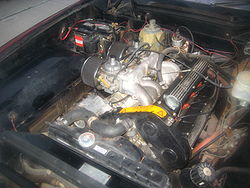
Lotus 907
Encyclopedia

Lotus Cars
Lotus Cars is a British manufacturer of sports and racing cars based at the former site of RAF Hethel, a World War II airfield in Norfolk. The company designs and builds race and production automobiles of light weight and fine handling characteristics...
. It was an original design, dual overhead cam, 16 valve all alloy powerplant. It displaced 1973 cc and developed approximately 144 bhp with dual sidedraft Dell'Orto
Dell'Orto
Dell'Orto is an Italian company, headquartered in Cabiate, specialized in the construction of carburetors and electronic injection systems. The company was founded in 1933 as "Società anonima Gaetano Dell'Orto e figli"...
carburetors. It was nicknamed "The Torqueless Wonder" for its lack of bottom end but good high end horsepower.
It is said that when Vauxhall unveiled its new slant-four engine
Slant Four
The Slant Four is a type of car engine manufactured by Vauxhall Motors and in modified form by Lotus Cars. Unveiled in 1966, it was one of the first production overhead camshaft designs to use a rubber toothed belt to drive the camshaft from the crankshaft , a method developed in 1956 by Bill...
at the 1966 Earls Court
Earls Court Exhibition Centre
The Earls Court Exhibition Centre is an exhibition centre, conference and event venue located in west London, United Kingdom in the Royal Borough of Kensington and Chelsea . It is the largest exhibition venue in central London. It is served by two underground stations, Earl's Court and West...
Motor Show
British International Motor Show
The British International Motor Show is an automobile show held biennially in the United Kingdom. It is recognised as an international show by the Organisation Internationale des Constructeurs d'Automobiles. The 2008 was the last event with no news of a return of the British International Motor Show...
its bore centers were exactly the same as those proposed by Lotus. Colin Chapman
Colin Chapman
Anthony Colin Bruce Chapman CBE was an influential British designer, inventor, and builder in the automotive industry, and founder of Lotus Cars....
immediately negotiated a deal with Vauxhall to buy some of their cast-iron blocks so that development of Lotus' own aluminum cylinder head could be sped up to produce the 907 engine.
The Lotus 907 was the first production variant of the Lotus 900 series engine.
Jensen-Healey
The Jensen-HealeyJensen-Healey
The Jensen-Healey is a two-seater convertible sports car that was originally produced between 1972 and 1976 by Jensen Motors, Ltd. Roughly 10,000 were produced at West Bromwich, England. A related fastback, the Jensen GT was introduced in 1975.-Design:...
was the first production car to receive the Lotus
Lotus Cars
Lotus Cars is a British manufacturer of sports and racing cars based at the former site of RAF Hethel, a World War II airfield in Norfolk. The company designs and builds race and production automobiles of light weight and fine handling characteristics...
907.
Lotus Espirit
The original Lotus Esprit, the Lotus EliteLotus Elite
Not to be confused with the Lotus Elise.The Lotus Elite name was used for two vehicles from Lotus Cars.-1957:The first Elite or Lotus Type 14 was an ultra-light two-seater coupé, produced from 1958 to 1963....
, and the Lotus Eclat
Lotus Eclat
The Type 76 and Type 84 Lotus Eclat, built from 1974 to 1982, was a front engine rear drive coupe. It was based on the Lotus Elite but had a fastback body style which offered more practicality with storage in the boot ....
, were fitted with a 907 engine. Developments to this engine resulted in the subsequent type 910, 912 and the V8 type 918
Problems
Oil leakage was commonplace in the first few years of production, though the problem was eventually addressed by aftermarket cam cover gaskets made from reusable rubber. Later 900 series Lotus engines included a revised cam tower that greatly improved the cam cover sealing design. The later cam towers can be retrofitted to the earlier 907 engines. Early Jensen-HealeyJensen-Healey
The Jensen-Healey is a two-seater convertible sports car that was originally produced between 1972 and 1976 by Jensen Motors, Ltd. Roughly 10,000 were produced at West Bromwich, England. A related fastback, the Jensen GT was introduced in 1975.-Design:...
engines (1972–1973) had oil supply issues that made the oil pressure slow to build on start-up. Some early engines also had issues with oil drainage which resulted in too much oil being retained in the cam carriers. Differences between early and late 907 engines included rope seals for the rear of the crankshaft versus regular spring-loaded rubber lip seals for the rear of the crankshaft on later 907 engines.
In addition to these problems, rebuildable water pump cores are getting hard to find and new water pumps are no longer being manufactured.

